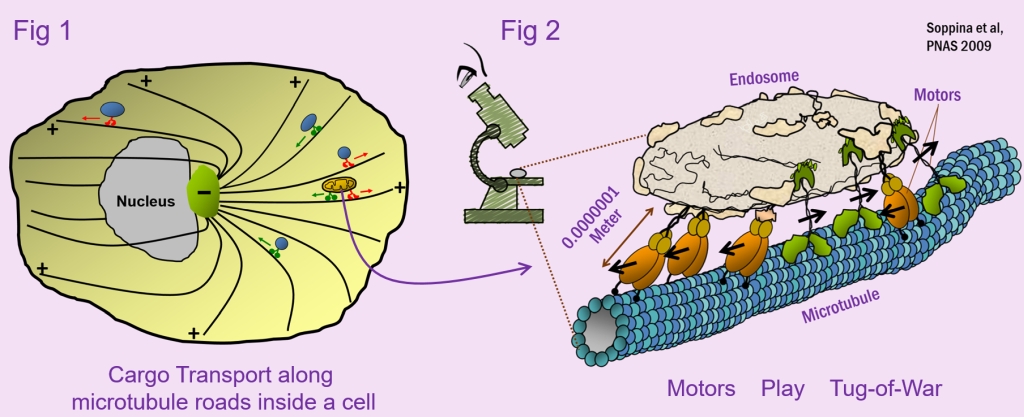Namaste. Welcome to the Laboratory headed by Roop Mallik at the Department of Biosciences and Bioengineering, Indian Institute of Technology Bombay (BSBE-IITB).
What is Life without motion? This motion can be visible, like a bird in flight, or not so easily seen like the incessant motion within the tiny cells inside the wings of the bird. We are interested in the molecules – “Motor” Proteins – that power such motion. These Motors also power the beating of your heart, so you could call them the Engines of Life. Our research spans the disciplines of Biology, Physics, Chemistry and Computation. As Physicists and Engineers, can we learn from nature how to design robust machines at the Nanoscale? As Biologists, can we relate the wiggling of a molecular machine to bacterial infections, neuronal disease, obesity & diabetes, left-right asymmetry inside the body? As Computer scientists and Mathematicians, can we understand how the collective efforts of these machines create order from disorder? This is Nanotechnology by Nature, as real as flesh and blood, working away quietly within trillions of cells inside you doing almost everything that you think you did.
MOTIVATION Ideas and tools from the physical sciences, when applied to biological problems, have yielded some of the deepest insights into the molecular dances that sustain life. Quantitative answers have been obtained through novel techniques, such as those invented to measure function of a single biological molecule. Such “single molecule” experiments are typically done with the molecule placed in an artificial (in vitro) environment. While these experiments are pioneering in their own right, it is usually not possible to relate their findings to real-world biology. This is because inside a cell, there is almost never anything like a “single” molecule. Biological processes usually require larger complexes, where several molecules (e.g. proteins and lipids) come together to achieve a common function. It is the NET function of this complex that is relevant, and not just that of the single constituent proteins. Our goal is to take a middle path where we extend the precision of single-molecule techniques inside living cells, or in reconstitution assays, and directly measure function of lipid-protein complexes in real-time in a cellular environment.
FOCUS The living cell is an assembly of specialized factories with a constant give-and-take of material occurring between these factories. Nanoscale proteins called Molecular Motors carry cellular material as “cargo” from one factory to the other (e.g. mRNA, virus, bacteria, endosomes – Figure 1). This transport is essential for the cell and its factories to function, and also for many pathogens to multiply inside human cells. Incessant movement of cargoes of different sizes and shapes can be observed under the microscope inside living cells. The motors attach to specific cargo, and walk in a step-like manner on tracks such as “Microtubules” (Figure 1). In order to walk, the motors generate forces about a million-million times smaller than what we use in our day-to-day life. These machines are the unit generators of force for most cellular processes. They are the Engines of Life, or the Engines of death if they are carrying a dangerous pathogen. As with everything in biology, complexity throws up a challenge — different motors with inclination to walk in different directions are usually present together on a given cargo, along with a host of other non-motor proteins (Figure 2; note the direction of arrows on motors). How do these antagonistic motors work together? A visually beautiful, evolutionarily important and commonly seen example of this competition between motors can be seen when fish and chameleons change colour.
The obvious, yet most remarkable thing about molecular motors is that they move. We record and analyse this motion, measure the forces needed to drive motion using optical tweezers, try to identify the molecules behind this using protein biochemistry, and also interfere with the motion using genetic/biochemical techniques. We use the microtubule-motor dependent motion of endosomes, phagosomes and lipid droplets as our model systems, and interrogate these systems at multiple levels of complexity. And then, there are the lipids on the membrane of the cargo which provide a platform for the motors to assemble before they can generate force. Lipid-motor interactions are therefore likely to be a central determinant in many mechano-biological processes, but very little is known. We are working to understand this alliance between Motors and Lipids in the context of Liver disease and pathogen degradation. Visit the PROJECTS webpage for more details.
- Here is an animation from the Hoogenrad Lab “Day in the Life of a Motor protein”.
- Here is a Lecture on Motor proteins by Ron Vale taken from the iBiology Seminars Webpage
- Here is a TEDx talk by Roop on these little engines.

